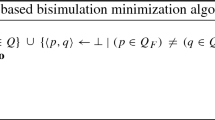Abstract
This work presents a minimization algorithm. The algorithm receives a Kripke structure M and returns the smallest structure that is simulation equivalent to M. The simulation equivalence relation is weaker than bisimulation but stronger than the simulation preorder. It strongly preserves ACTL and LTL (as sub-logics of ACTL*).
We show that every structure M has a unique up to isomorphism reduced structure that is simulation equivalent to M and smallest in size.
We give a Minimizing Algorithm that constructs the reduced structure. It first constructs the quotient structure for M, then eliminates transitions to little brothers and finally deletes unreachable states.
The first step has maximal space requirements since it is based on the simulation preorder over M. To reduce these requirements we suggest the Partitioning Algorithm which constructs the quotient structure for M without ever building the simulation preorder. The Partitioning Algorithm has a better space complexity but might have worse time complexity.
Preview
Unable to display preview. Download preview PDF.
Similar content being viewed by others
References
Aziz, A., Shiple, T.R., Singhal, V., Sangiovanni-Vincetelly, A.L.: Formula- dependent equivalence for compositional CTL model checking. In: Dill, D.L. (ed.) CAV 1994. LNCS, vol. 818, pp. 324–337. Springer, Heidelberg (1994)
Aziz, A., Singhal, V., Swamy, G.M., Brayton, R.K.: Minimizing interacting finite state machines: A compositional approach to language containment. In: Proceedings of the International Conference on Computer Design, pp. 255–261 (1994)
Bloom, B., Paige, R.: Transformational design and implementation of new efficient solution to the ready simulation problem. Science of Computer Programming 24, 189–220 (1996)
Bouajjani, A., Fernandez, J.-C., Halbwachs, N.: Minimal model generation. In: Clarke, E.M., Kurshan, R.P. (eds.) Computer-Aided Verification, New York, pp. 197–203. Springer, Heidelberg (1990)
Bouali, A., de Simone, R.: Symbolic bisimulation minimisation. In: Probst, D.K., von Bochmann, G. (eds.) CAV 1992. LNCS, vol. 663, pp. 96–108. Springer, Heidelberg (1992)
Bustan, D., Grumberg, O.: Simulation based minimization. Technical Report TR #CS-2000-04, Computer Science Department, Technion, Haifa (April 2000)
Clarke, E.M., Emerson, E.A.: Synthesis of synchronization skeletons for branching time temporal logic. In: Kozen, D. (ed.) Logic of Programs 1981. LNCS, vol. 131. Springer, Heidelberg (1981)
Clarke, E.M., Grumberg, O., Peled, D.A.: Model Checking. MIT press, Cambridge (1999)
Fisler, K., Vardi, M.: Bisimulation minimization in an automata-theoretic verification framework.In: FMCAD, pp. 115–132 (1998)
Grumberg, O., Long, D.E.: Model checking and modular verification. ACM Trans. on Programming Languages and Systems 16(3), 843–871 (1994)
Henzinger, M.R., Henzinger, T.A., Kopke, P.W.: Computing simulation on finite and infinite graphs. In: Proc. Symp. Foundations of Computer Science, pp. 453–462 (1995)
Kucera, A., Mayr, R.: Simulation preorder on simple process algebras. In: Wiedermann, J., Van Emde Boas, P., Nielsen, M. (eds.) ICALP 1999. LNCS, vol. 1644, p. 503. Springer, Heidelberg (1999)
Lee, D., Yannakakis, M.: Online minimization of transition systems. In: Proceedings of the 24th ACM Symp. on Theory of Computing (1992)
Milner, R.: An algebraic definition of simulation between programs. In: Proc. of the 2nd IJCAI, London, UK, pp. 481–489 (1971)
Park, D.: Concurrency and automata on infinite sequences. In: Deussen, P. (ed.) GI-TCS 1981. LNCS, vol. 104. Springer, Heidelberg (1981)
Author information
Authors and Affiliations
Editor information
Editors and Affiliations
Rights and permissions
Copyright information
© 2000 Springer-Verlag Berlin Heidelberg
About this paper
Cite this paper
Bustan, D., Grumberg, O. (2000). Simulation Based Minimization. In: McAllester, D. (eds) Automated Deduction - CADE-17. CADE 2000. Lecture Notes in Computer Science(), vol 1831. Springer, Berlin, Heidelberg. https://doi.org/10.1007/10721959_20
Download citation
DOI: https://doi.org/10.1007/10721959_20
Publisher Name: Springer, Berlin, Heidelberg
Print ISBN: 978-3-540-67664-5
Online ISBN: 978-3-540-45101-3
eBook Packages: Springer Book Archive




